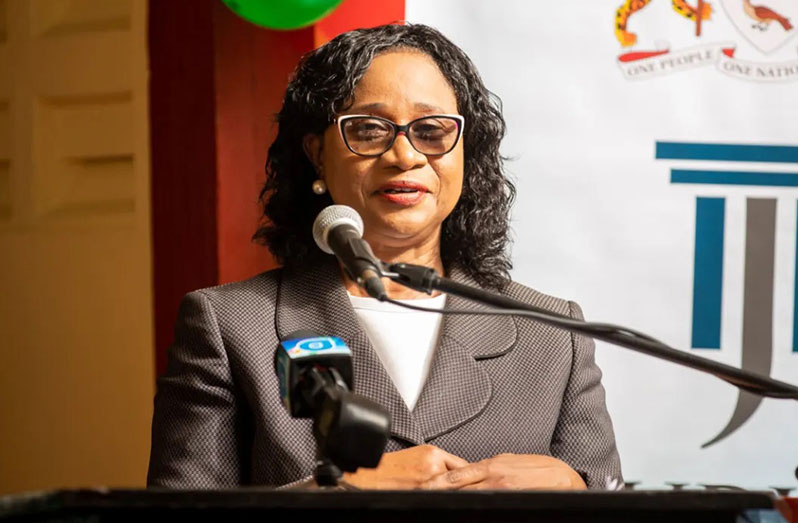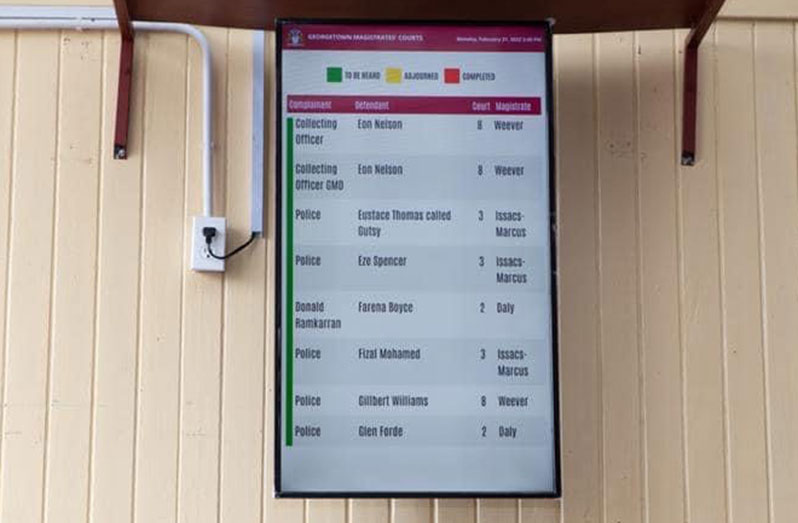THE Supreme Court of Judicature on Monday launched its Electronic Notice Boards at the Georgetown Magistrates’ Court to facilitate easier access to justice and to help propel the digital transformation of the judicial system.
The initiative which was launched virtually on the Supreme Court’s Facebook page, is supported by the Canadian Government and the Judicial Reform and Institutional Strengthening (JURIST) Project.
Chancellor of the Judiciary (ag), Justice Yonette Cummings-Edwards; Chief Justice (ag), Madam Justice Roxane George; Canada”s High Commissioner to Guyana, Mark Berman and Director of the JURIST Project, Gloria Richards-Johnson delivered remarks.
Among those who attended were Attorney-General Anil Nandlall, magistrates, judges, other senior judicial officers and members of the legal profession.

According to the Chief Justice, the boards will keep court users informed and decrease their waiting time in the environs of the court. She said that the latter is particularly important given the COVID-19 situation which necessitates the courts keeping crowding at a minimum.
The four digital boards were placed at strategic points at the city court and will soon be rolled out at other courts across Guyana.
“It marks another tangible demonstration of the new trajectory of the judiciary of Guyana. It signals our continued embrace of the necessity to accelerate the digital transformation of our court system,” Justice George said while delivering her remarks at the historical launch.
While chronicling the judiciary’s digital transformation throughout the years, the Chief Justice said that its genesis started sometime in 2010, when the court commenced Skype court hearings which later set the foundation for recording systems, live streams and social media platforms among other things. These in the long run allowed for speedier trials, she added.
The public education campaign was launched in 2020 and is designed to build public trust and confidence in the judiciary and the judicial system. She also spoke about the recent launch of the court website (https://supremecourt.gy) which provides general information and an online filing mechanism.
She explained to attendees that the judiciary’s continued collaboration with the JURIST project has given the court system the impunity to “think outside of the box.”
In what she deemed a “transformative period” for the court system, the Chief Justice said that soon a “case management system pilot project” will be rolled out in the Magistrates’ Court.
This project is a collaboration involving the National Centre for State Courts of the United States and a number of local and international judiciaries.
“Access to justice takes many forms. These digital boards are another mechanism for ensuring access to justice,” she said.
LAGGING BEHIND
Meanwhile, Canada’s High Commissioner to Guyana, Mark Berman, explained that courts have somewhat lagged behind when it comes to modern technology.

“Judicial system has traditionally been hesitant to embrace the constantly evolving technological advances we see in other sectors. But recently the legal profession, including the judiciary has begun to leverage technology to enhance the delivery of services,” he said.
On Monday, the Canadian High Commissioner handed over 15 laptops to the court, which he said will help boost its capacity to help administer justice.
“ We are all aware that now more than ever there is an urgent need for I.T (Information Technology) infrastructure to facilitate virtual hearing, to ensure that persons attend court and have their cases and complaints dealt with in a timely manner,” Berman added.
The Chancellor in her remarks said that this new initiative would assure the citizenry that the wheels of justice are turning despite the COVID-19 crisis.
She explained that the digital boards will assist court users with knowing the status of their cases and help them navigate their way around the court’s precinct.
“ We were moving slowly, perhaps on a turtle back on the technological road. Many of our courts were without recording units. The handwriting of the note of evidence was the order of the day; witnesses were asked to slow down as they give their testimonies or even to repeat aspects of their testimonies to afford accurate notetaking of the evidence by the judicial officer..,” she said.
She added: “Today JURIST has allowed us to boast that all of our courts are now equipped with facilities for recording of evidence which allows us to spend less time in writing of the evidence.”
The Chancellor explained that the judiciary’s “endgame” has always been to safely keep its doors open to meet the legal need of society.
She explained that court users can now see their matters via the user-friendly digital notice which will ultimately reduce the time spent in ascertaining which court a particular matter is in or which magistrate is presiding over the matter and the status of the case.
“We are open for business. We are expanding, new courts will be constructed this year, especially in the unserved areas. New courts will be built and opened next year. Already, the Attorney General has identified land in the Parfaite Harmonie area for us,” she disclosed.




.png)









